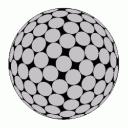Yahoo Answers is shutting down on May 4th, 2021 (Eastern Time) and beginning April 20th, 2021 (Eastern Time) the Yahoo Answers website will be in read-only mode. There will be no changes to other Yahoo properties or services, or your Yahoo account. You can find more information about the Yahoo Answers shutdown and how to download your data on this help page.
Trending News
Find k>1 such that x^2=k^x has exactly two real solutions for x.?
I don't know if there is a closed form for k, but a numerical answer accurate to 6 or more decimal places will be fine.
This seems numerically unstable, so computationally challenging.
2 Answers
- SqdancefanLv 76 years ago
In order for there to be exactly two real solutions, one of the intersection points between y=x^2 and y=k^x will be where the two curves are tangent to each other. That is, both the y values and the y' values will be equal at that point. This means we are solving the simultaneous equations ...
.. x^2 = k^x
.. 2x = (k^x)*ln(k)
Using the former in the latter, we have
.. 2x = x^2*ln(k)
.. (2/x) = ln(k)
.. k = e^(2/x)
Using this in the first equation, we have
.. x^2 = (e^(2/x))^x
.. x^2 = e^2
.. x = e
So, the value of k is e^(2/e), and the tangent point is (e, e^2).
.. k ≈ 2.0870652286345329598
_____
The other point of intersection is x=-e*ProductLog[1/e] ≈ -0.75694510645758
- JBLv 76 years ago
This is not an answer, just a test, because one answer that was here earlier has now disappeared. I may contact the answerer to see if he/she can enter it again, because I came here just now to award him/her best answer .... but it is gone! A Y!A bug, I guess.
Here is the exact answer that J wrote that has now disappeared. I found the answer quite interesting because I had no idea that the value of k could be given exactly in closed form. When I contacted him he said it had not disappeared for him. Hmmm. Here is J's answer:
Nice problem. After at least an hour working on this I found the exact answer, namely k = e^(2/e) ≈ 2.087065228634533. The solutions for that value of k are e and a number whose approximate value is -0.756945106457583664584. The double root is x=e.
Sorry, but the derivation details are too much for me to type in here.


